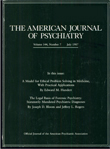Revisiting the factor structure for positive and negative symptoms: evidence from a large heterogeneous group of psychiatric patients
Abstract
OBJECTIVE: The factor structures of individual positive and negative symptoms as well as global ratings were examined in a diagnostically heterogeneous group of subjects. METHOD: Subjects were identified through a clinical and family study of patients with major psychoses at a VA medical center and evaluated with the Scale for the Assessment of Negative Symptoms and the Scale for the Assessment of Positive Symptoms. For the examination of global-level factor structures (N = 630), both principal-component analysis and factor analysis with orthogonal rotation were used. Factor analysis was used for the examination of item-level factor structures as well (N = 549). RESULTS: The principal-component analysis of global ratings revealed three factors: negative symptoms, positive symptoms, and disorganization. The factor analysis of global ratings revealed a negative symptom factor and a positive symptom factor. The item-level factor analysis revealed two negative symptom factors (diminished expression and disordered relating), two positive symptom factors (bizarre delusions and auditory hallucinations), and a disorganization factor. CONCLUSIONS: The generation of additional meaningful factors at the item level suggests that important information about symptoms is lost when only global ratings are viewed. Future work should explore clinical and pathological correlates of the more differentiated item-level symptom dimensions.



